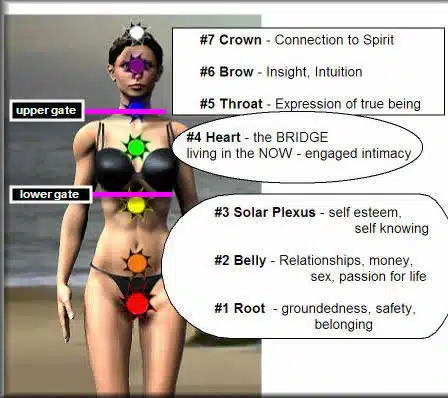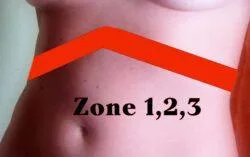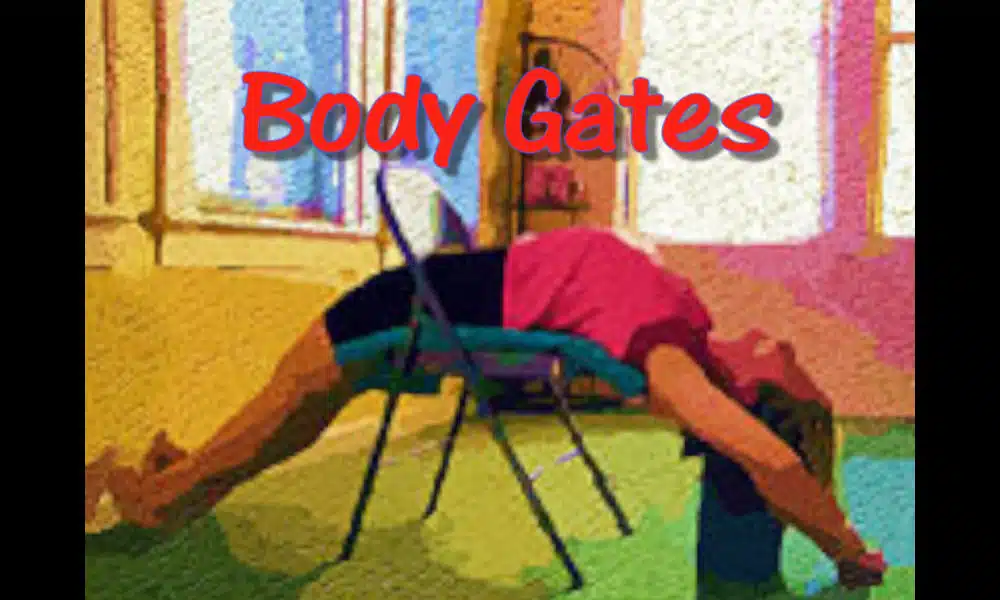- Untwisting
- Getting out of Bondage
- Bodywork
- Body Gates and the Path to Self-Knowing
- My Husband and My Pelvis
- Drama and Being Twisted
Body Gates — there are gates in the body — metaphoric passages from one stage of development to another. We look at moving into the “full expression of self” — into full being.

Want to learn more about living a full and meaningful life?
Want to have the best relationship ever?
Check out my books
Many moons ago, a client of mine e‑mailed a story of an interaction. She and her partner had a conversation (sort of) about the state of the relationship. What became clear was that they were coming at the relationship from two different perspectives. She also mentioned some pain in her collar-bone area, and I remembered that her upper back had been quite sore during her previous Bodywork session.
I wrote back, and half way through, realized that what I was writing would be a beneficial article about Bodywork and relationships. What follows is my take on the issue my client raised, with notes.
I replied with two things:
- 1) some stuff on bodywork, and
- 2) some stuff on relationships.
The chakras are energy centers, and each is concerned with an aspect of physical, emotional and spiritual development. In a sense, they tell the story of our lives, and provide the energy for transformative being.
What follows is a metaphor that demonstrates the path to full and vibrant living.
According to Eastern thought, there are at least two “diaphragms” or “gates between” in the body. The first is between the solar plexus and the heart, and the second is in the vicinity of the throat.

Let’s talk chakras, but these zones also exist in Chinese medicine.
Here’s the pattern in simplified form.
In the coding below the | represents the gates.
It’s 1,2,3 | 4 | 5,6,7
Chakras 1, 2, and 3 are the physical chakras, and sadly, most people stay stuck in these 3.
The 3 represent:
- Root — security, stability, existence
- Belly — relationships; he we relate to everything and everyone.
- Solar Plexus — self-esteem
The “zone” made up of chakras 1, 2, and 3 is the zone of stability, relationships, and self-esteem.
My client discovered that her partner’s self-esteem is connected to job, money, “cleanliness,” tidiness, order, control, etc. For him, any form of “clutter” became a self-esteem issue.
He thought: “If I see a mess, I feel bad about myself, and assume it is either an insult (I blame others for my messes) or I blame myself for not trying hard enough.“
With effort you can move past zone 1,2.3

However, because of the strength of the first diaphragm or gate, most people do not move out of this very physical realm.
They have a vague sense of “something more,” but no clue how to get there, so they keep messing around in familiar waters. They change jobs, partners, obsess, clean, move their piles from one place to another, try to be happy by making more money etc, and this tension and drive to shift piles seems normal–as in, “What I’m stuck with.”
You get yourself unstuck by identifying the 1,2,3 zone, owning it, and then coming to a new understanding, which might be thought of as the “spiritual” / vocational aspect of living. This begins at the heart.
Zone 4–The heart chakra is the intermediary between physical (1,2,3) and the spiritual (5,6,7)
Openheartedness is the first step on a long walk into vocational, present, “in the moment” living. This requires simple acceptance — of others, of self, of the Taoist principle. “The way it is, is the way it is.“
The Heart Chakra is the locale of “being,” (as opposed to “doing,” which is the realm of Zone 1,2,3) and is sensed as “emptiness” (as in, “empty of meaning”)
This is not nihilism, but rather symbolized by the emptiness that comes in between thoughts when meditating, for example.
The next diaphragm, at the shoulders, is interesting.

You could, I suppose, “live” at the heart level, and simply be a sort of passive acceptor of “whatever.” This, to me, seem disingenuous, and somewhat self absorbed.
The transition, the process of moving through the upper gate or diaphragm, leads to the expression of (the actual living of) an egoless spiritual life.
This transition requires the use of 5,6,7
- The throat — which stands for the release of true self into the world, metaphorically through speech, is actually about expressing the totality of one’s being.
- The Third Eye — Insight — intuition, and the ability to see what’s really going on.
- Transcendence — satori, enlightenment, etc.
If there is a block at the shoulder diaphragm, getting past it requires actualizing the first 4. The work is to assimilate the 1,2,3, (physical zone,) with the heart (4), so that all physical being and acting is done out of compassion.
As Lama Marut put it:
“Compassion for others is impossible until you care enough for yourself to really want to stop your own suffering.”
My client wrote a list of her priorities for life:
Her list was, in the order she chose: love (chakra 4), taking care of self (chakra 3), taking care of others ( chakra 2) — Footnote: our real work is self work, so the language of her last priority is not correct. We can care about others, but can never take care of others. That is their job.
Notice the direction of my client’s list — hint — it’s downward, toward the root chakra, which means it’s focused on stability and security, as opposed to moving past whatever issue arises by transcending it.
My list might be: being loving (an action), being direct and clear, being myself, and deepening my connection to that which is. Notice that there is only “me” in this — yet if I do “me” well, those around me benefit. The direction is upward and inclusive.
Back to my client’s partner. He was fighting off self-created Chaos by trying to establish rules and structures.
- He cleans when he comes home, not to punish my client or to ignore her, but to try to keep his collapsing, chaotic world together. If the house was spotless, he would create another issue to obsess about.
- My client’s partner was stuck trying to make his little feetsies run fast enough to keep all the balls in the air. He had to to crash and burn before he realized the futility of this path.
My client’s job was to keep him talking, while asking, repeatedly, “How’s that working for you?“He stayed stuck until he saw the impossibility of structuring himself into happiness.
Question everything, and get rid of what does not work.
This was the stage my client was at when she emailed, and it was expressed through pain at the upper or second diaphragm or gate–at her shoulder blades, upper shoulder muscles, and her collar-bone.
My client had rules about who she was and how she was, and she often got stuck defending them, intellectually and physically. Ultimately, she learned to laugh at her rules, rather than fiddling with them — she learned to have her experience(s) as opposed to trying to force them to fit her no longer useful rules.

